It has been a while since I’ve gotten to do one of these. Following the Indianapolis Invitational and before the Baltimore Standard Open, it was announced that Jace, the Mind Sculptor and Stoneforge Mystic would be banned in Standard play. That left me with two tournaments filled with irrelevant data sets about decks that would never grace our web pages again. Of course, the exodus of those two cards immediately preceded the arrival of Magic 2012, which meant that the environment was due for some shake-ups. With that in mind, I decided to hold off on writing another entry in this column until there was a metagame worth reading about.
Well kids, it’s here.
The Cincinnati Standard Open featured new Standard in considerable glory, and it’s one of the most interesting events we’ve held in some time. Over 400 players showed up, and the metagame featured the kind of diversity it has lacked for some time now. There’s a lot to discuss beyond the numbers, but let’s go ahead and get the numbers out of the way first.
Below is a population chart, recording the decks that participated in the tournament and their total records, along with a win percentage against the field. While the records include mirror matches, each deck’s win percentage excludes mirror matches in order to prevent a percentage that naturally trends toward the 50% baseline.
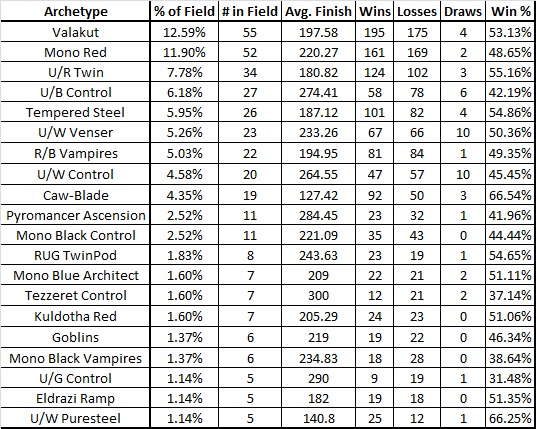
The first thing you’ll notice is that the hype was right—Valakut and Mono Red were two of the biggest decks in Cincinnati, with U/R Twin a distant third. In this case, I’m chalking their popularity up to self-fulfilling prophecy, however. So many writers and players entered the new world believing these decks to define the format that it inflated their numbers. The wiser players came prepared, and it paid off.
Examine the Top 16 decks on our website. You’ll notice no Valakut or Mono Red players managed to crack the Top 8, and only two Valakut players made it to the Top 16. That’s a far cry from the metagame-dominating force that most players were concerned they would face with Jace gone. Valakut remained a pole of the format, rather than its top contender, while players came prepared to beat Mono Red and did so successfully. I saw a lot of Wurmcoil Engines and Kor Firewalkers in Cincinnati, so fire mages beware!
In fact, the decks with the most appearances in the Top 16 were different flavors of U/W builds: Caw-Blade, Control, and Puresteel Paladin occupied nearly half of the Top 16, with four Caw-Blade pilots total and two in the Top 8.
No, the sky is not falling.
You can trace several elements to Caw-Blade’s success. The first one is that the cards are still good, even without Stoneforge Mystic—Brian Kibler Caw-Go deck performed well before PT Paris, and this is certainly a new and improved version of that deck by miles. The second is that these are cards many talented players have already grown accustomed to, and they wield them with a seasoned dexterity. Drawing on their previous experience gave these players an edge against a lot of competitors looking to make it with a new brew or an untested version of an old classic. As we uncover more decks and players lock into different lists, I expect we’ll see Caw-Blade’s numbers—and its success—dip significantly. The deck is far from dead, but the purpose of the banning wasn’t to kill Squadron Hawk. It was to balance a format in need of the help.
Returning to the metagame chart, only one deck challenged Caw-Blade in sheer success against the field: U/W Puresteel. Caleb Durward’s pet deck has enjoyed some success on MTGO and became a major player in Cincinnati, with four players going relatively deep in the event. Caleb’s semifinal match against Vampires displayed one of the deck’s central weaknesses, and I doubt Puresteel will enjoy the same success in the weeks to come. People will figure out that once you fracture the deck’s synergistic elements, you’re just playing against a bunch of Swords and Flayer Husks.
No one was surprised to see U/R Twin remain a viable archetype, but Tempered Steel’s charge was unforeseen by most. Like Puresteel Paladin, it’s another Scars Block deck in appearance that functions powerfully well in Standard, especially when players fail to respect it. Explosive starts combined with Dispatch to keep an opponent off-balanced will continue to make Tempered Steel a deck to watch. If you don’t keep it in mind, odds are one of its savvy pilots will prey on you, just as Kyle Dembinski and Dave Shiels did all weekend long.
With these numbers in mind, let’s take a look at our matchups. As is Standard, the matchups will examine each Tier 1 deck as paired against its fellows, with Tier 1 defined as occupying 5% of the field or more.
Valakut — 12.59% of Field — Won 53.13% of Matches
Best Finish: Garrett Young, 13th place
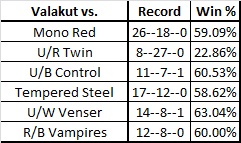
Many players believed Valakut to be the next bogeyman of Standard, but our early results show the deck to just be one more archetype in a healthy Standard format. The advancements made in Valakut put a number of interesting additions on display. Thanks to Rampant Growth and Solemn Simulacrum, Valakut can now operate on a 2-4-6 curve that plays slightly more efficient spells at each level, with Overgrown Battlement replacing Lotus Cobra once again. Its beatdown plan has also improved significantly, with Urabrask the Hidden joining most creature lineups.
The verdict is in: Green Sun’s Zenith is better than Summoning Trap! But I think most of us had already figured this out, so that’s not much new. Beast Within has enjoyed some success, and offers an answer to Torpor Orb that may wind up becoming more and more necessary. I like the artifact a lot in this format.
Valakut is a great deck in this metagame, as its (mostly) strong matchups suggest, but being a monstrous dog to Twin decks means that any pilot has their work cut out for them. Solving that matchup might just give someone the key to the city.
Mono Red — 11.90% of Field — Won 48.65% of Matches
Best Finish: N/A
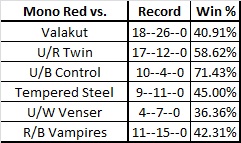
It’s not a coincidence that Mono Red was shut out of the Top 16. While Mono Red has a lot of powerful cards—and right now bears a disturbing resemblance to its Legacy counterpart—the current incarnations were bested time and time again by opponents packing not just cars, but strategies that were well-positioned against the Mono Red menace.
Obstinate Baloth has continued to be a thorn in most players’ sides. AJ Sacher and others chose Torpor Orbs to defeat Valakut’s sideboard and its primary strategy, with Act of Aggression following a blank Titan often resulting in victory. However, U/W won the day in Cincinnati, and will continue to be a tough matchup for anyone working Mountain Magic. With Seattle on the horizon, it might be time to put the Mountains down until someone shows Squadron Hawk whose boss.
I find myself awkwardly hoping Patrick Sullivan doesn’t make me eat my words (again) this weekend…
U/R Twin — 7.78% of Field — Won 55.16% of Matches
Best Finish: Jason Hager, 6th place
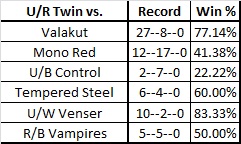
Many of the decks in this format existed prior to pro Tour Paris—U/R Twin was not one of them. The printing of Deceiver Exarch in the interim created a very different problem in Standard, demanding that decks actually interact with one another in powerful ways early on. Dismember has given everyone a way to do so, which has kept Twin rather solidly in check.
The same deck crushing Twin at the StarCityGames.com Orlando Open has continued to do so—U/B Control. The combination of disruption, card advantage, and counterspells not only buries the Twin archetype, but also keeps it from digging out of the ground at all. A miserable matchup that seems strategically unsound, Most players audible to a different engine in order to beat this matchup.
The thing that weirds me out is how undecided players are on the basic skeleton of this archetype. Should it be U/R or Grixis, or maybe even W/U/R? Should you board Pyromancer Ascension or Calcite Snappers as a backup plan? Do you even want a backup plan? These are questions each pilot needs to answer, but the jury’s out on an optimal configuration.
U/B Control — 6.18% of Field — Won 42.19% of Matches
Best Finish: N/A
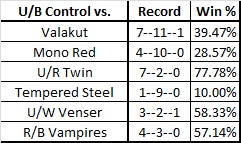
Speaking of U/B Control, ta-da! U/B Control became an early favorite on MTGO prior to the release of Magic 2012, but the release of Oblivion Ring and Grim Lavamancer have given it some trouble. Turning around the Mono Red matchup is important, and I expect most players to turn to Wurmcoil Engine and perhaps Vampire Nighthawk for aid here.
The fact that Valakut broke ahead of U/B Control speaks to lazy construction on the part of the control players, in my mind. U/B has historically been very good in the matchup, but Valakut has gotten better and the U/B Control players have decided to skimp a bit. Start respecting the beast again, or he will consume you whole. Remember kids, this matchup was a lot easier when you could cast Jace, the Mind Sculptor and giggle at your opponent.
Oh, and uh, don’t play U/B Control if Tempered Steel is big in your metagame. Ten matches is a small sample size, but I watched a fair few of those games.
They were ugly.
Tempered Steel — 5.95% of Matches — Won 54. 86% of Matches
Best Finish: Dave Shiels, 5th place
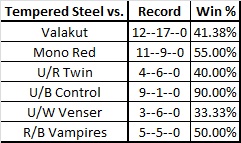
Block Constructed superstar Tempered Steel jumped to the big leagues, one of two decks to post double Top 8 finishes this weekend. The other was Caw-Blade, but worth considering are these decks’ pilots. Kyle Dembinski is no slouch and a seasoned grinder, but Dave Shiels and Caw-Blade were virtual synonyms last year. He followed a Grand Prix win in Dallas with strong finishes on the Open Series, but without Stoneforge Mystic he turned to a new weapon.
Tempered Steel was clearly a powerful choice this weekend, boasting a reasonable overall win percentage and the runs of these two players, but its Tier 1 matchups are swingy to say the least. I think we saw the most from Tempered Steel that we’re going to see for a while this weekend, as players adapt to include it in their gauntlets and consider their matchups with the artifact aggro deck during testing. In short, this deck deserves some time in the limelight, but I wouldn’t expect it to shine much longer.
U/W Venser — 5.26% of Matches — Won 50.36% of Matches
Best Finish: Matthew Woolum, 16th place
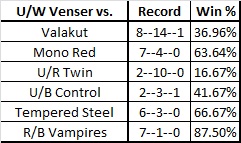
I love Venser, but you probably shouldn’t be playing him.
There’s more to the archetype than that, of course, but not much. Venser-based U/W decks did fine this weekend, beating up on linear aggro strategies and fighting uphill battles against control and combo opponents. Is that where you want to be? Probably not, in all honesty. I think traditional U/W Control is just too passive for this Standard format, a format where even the other control decks are looking to hit you in the face.
If you’re looking to grind it out with a fun deck that has lots of minor interactions but little in the way of game-winning power, then by all means sleeve up this deck. Frankly, reacting to my opponents plays over and over while manipulating my cards for synergies that are cool but not killer does not sound very appealing to me. Attacking is just too good in this format, and tapping out for Venser remains quite risky. Elspeth Tirel and Gideon both seem better positioned to me.
R/B Vampires — 5.03% of Matches — Won 49.35% of Matches
Best Finish: Matt Farney, 2nd place
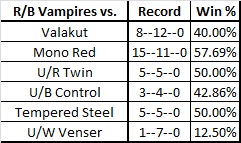
Vampires enjoyed a significant amount of success during the reign of Caw-Blade, so it’s no surprise to see this tribe continue to put up strong finishes. I’m actually a little surprised that only one made the Top 16, but he did get all the way to the finals before falling to the Caw-Blade menace, so take that into consideration. Red does seem better than the mono-black variety once again, and with Bloodthrone Vampire departing soon I doubt that will change anytime soon.
My favorite aggressive deck in the format, Vampires attacks on multiple levels and displays a considerable amount of reach, as it always have. Assembling Bloodghast and Viscera Seer or Kalastria Highborn—or both—will let you pound through just about anything, and few plays are as disheartening as turn 3 Gatekeeper of Malakir with kicker. It’s not a coincidence that Blade Splicer triumphed in this matchup, guys.
That said, I could see a R/B aggro deck becoming heir to this legacy, taking advantage of some of these creatures and running a few other spicy aggressive ones, like Stormblood Berserker. Time will tell.
The next stop on the StarCityGames.com Open Series circuit is Seattle this weekend, and I couldn’t be more excited. You’ll get to hear all about the ways in which Seattle is one of my favorite cities later on, but the important things to remember are:
- I’ll be there.
- SCGLive’s new director and the man who has made my life a zillion times easier, Jeremy Noell, will be there.
- Local mage and all-star commentator Gavin Verhey will be there.
- Last but not least, Player of the Year Brad Nelson will be there, commentating alongside Gavin all weekend with his own unique insight.
You’ll also get to hear more about Brad Nelson biography, Grinder: The Story of Brad Nelson, as written by fellow coverage reporter Rich Hagon, one of Magic’s true storytellers. I’ve read the book several, several times now as part of working with this project, and you’ll be able to purchase the complete work on Monday for only $9.99 through a variety of eBook services. It’s a unique and piercing look into one of the stories that has defined Magic in the modern era, and I know I left the book with a lot more than I imagined I could ever glean from such a story. If you enjoy biographies and Magic, it’s certainly a recommended read.
Seattle’s shaping up to be just as exciting as this Standard format, and I’m looking forward to what will be one of the best Opens of the year. We’ll have more surprises in store for you as the season continues, but you’re just going to have to wait to hear all about them!
Coverage Content Manager
@SecludedGlenn
